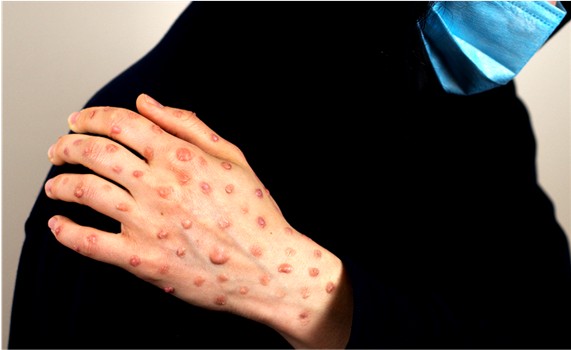
STOCK PHOTO: Woman's Hand with Monkeypox Rash
FRANKFORT, KY – Public health officials announced on Friday June 24, 2022 that the first probable case of Monkeypox in Kentucky in 2022 has been identified in a Jefferson County resident.
Initial testing was completed at the Kentucky Department for Public Health (KDPH) Division of Laboratory Services. Confirmatory testing is pending at the Centers for Disease Control and Prevention (CDC). Based on the initial positive test and preliminary case investigation, state health officials consider this a probable Monkeypox infection. The patient remains isolated, and health officials are working to identify anyone the patient may have had close contact with while infectious. No further information about the patient will be released due to privacy concerns.
As of June 23, 2022, the CDC reports that 173 Monkeypox cases have been identified in 24 U.S. states. More information about the Monkeypox outbreak is available on the CDC’s website.
State Public Health Commissioner Dr. Steven Stack said, “Identifying the first case of Monkeypox in Kentucky is concerning but not surprising. Fortunately, the risk to the general public remains low. We continue to work closely with CDC and our local health department and healthcare partners to contain the spread of this virus.”
Person-to-person transmission is possible either through skin-to-skin contact with body fluids, Monkeypox sores or contaminated items, such as bedding or clothing, or through exposure to respiratory droplets during prolonged face-to-face contact.
Monkeypox typically begins with flu-like illness, including fever and swelling of the lymph nodes about five to 21 days after exposure, followed by a rash or lesions one to three days later. The rash or lesions are often painful and typically begin on the face but may occur on any part of the body. The illness typically lasts for two to four weeks. People are considered infectious from the time that symptoms start until all scabs from the rash have fallen off and the skin has healed.
To prevent the spread of Monkeypox in Kentucky, KDPH is asking individuals to be aware of the risks and how Monkeypox spreads. It is also important to remember that Monkeypox can spread through sexual networks, therefore KDPH urges you to be vigilant. People who have symptoms of Monkeypox, particularly the characteristic rash or lesions, should take the following steps:
- Visit a medical provider for an evaluation
- Cover the area of the rash with clothing
- Wear a mask
- Avoid skin-to-skin, or close contact with others
Individuals with questions about Monkeypox should speak to their primary care provider. In addition, people without a regular provider that have developed a rash in the genital or perianal area, can access services at local health department sexual health clinics.
KDPH is urging healthcare providers across the commonwealth to be alert for patients who have rash illnesses consistent with Monkeypox:
- Monkeypox infection should be considered for patients presenting with skin lesions, especially for those with a history of recent travel to an area with confirmed Monkeypox cases or who have close skin-to-skin contact (such as sexual contact) with new or affected partners.
- Take note that some patients have had genital lesions and the rash may be hard to distinguish from syphilis, herpes simplex virus (HSV) infection, chancroid, varicella zoster, and other more common infections.
- Isolate any patients suspected of having Monkeypox in a single-person room, and ensure staff understand the importance of wearing appropriate personal protective equipment (gown, gloves, eye protection, and respirator) and that they wear it each time they are near suspected cases.
- Use standard cleaning/disinfectants in accordance with the manufacturer’s instructions and dispose of any materials that touched the patient as medical waste.
- Report all suspected Monkeypox cases to Public Health immediately. Additional information is available on the KDPH website.
-30-
The Cabinet for Health and Family Services is home to most of the state's human services and health care programs, including the Department for Medicaid Services, the Department for Community Based Services the Department for Public Health, the Department for Aging and Independent Living and the Department for Behavioral Health, Developmental and Intellectual Disabilities. Information on how the cabinet is improving the lives and health of our people is available at CHFS.ky.gov. Follow the cabinet on Facebook, Twitter, Instagram and LinkedIn.









